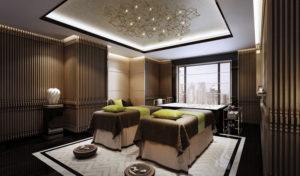NEW YORK—People are busier than ever—or, at least, it seems that way. Instead of technological advances freeing up more time, people are left starving for leisure and connection. Sleeping with smartphones tucked under pillows, being tethered to the office unable to fully disconnect, and sneaking peeks at a mobile device during family dinner is the new reality—and it’s having an impact on one’s health and happiness.
Loneliness is a global epidemic, due in part to social media, technology and hot-desking—random desk assignments—making it easier to avoid real-life relationships and creating less face-to-face interaction, according to findings in a white paper produced by global design firm WATG (Wimberly Allison Tong & Goo), based here.
There’s a reason why hotels with communal tables are trending. The popularity stems from people’s craving for social interaction and desire for community, while hospitality venues seek to maximize space and create a buzz that is attractive to other guests. It’s a win-win by design.
WATG’s researchers and designers are actively watching trends and societal shifts to create hospitality spaces that help to impart a feeling of wellness, as well as a connection to oneself and the environment.
“The world’s population increasingly understands the importance of taking care of the human body and mind. This growing awareness of well-being has influenced a number of sectors, perhaps none more so than the hospitality industry,” said Andrea Lindgren, research analyst at WATG and Wimberly Interiors.
In the study, WATG identified ways in which architecture and design have been found to enhance well-being. For example, the development of buildings—especially hotels—that make occupants both healthier and happier is growing significantly. Sensory management is a key component of wellness design, with consideration given to the careful control of light (for example, circadian lighting, to control mood and body clock), temperature, air quality and noise.
Direct and indirect exposure to nature has also proven to have significantly positive impacts on mental and physical health, which has led to a sharp rise in biophilic design. The resulting emerging style, which brings nature indoors, is something WATG predicts will become a basic philosophy throughout the hotel sector. This design style is created not just by bringing greenery and gardens indoors, but also via seamless transitions between indoors and outdoors. Soneva Jani, a luxury eco-resort in the Maldives, offers villas with retractable roofs, allowing guests to watch the stars instead of TV.
The interconnection between wellness and sustainability is another way WATG found architecture and design can enhance well-being. Hotel resorts are increasingly making real commitments to sustainability without compromising on comfort and luxury, offering true eco-integrity and allowing guests to refocus on improving human health and giving back to their planet. The Lefay Resort & Spa Lago di Garda in Northern Italy became the first hotel in Southern Europe to receive the Green Globe environmental certification, according to WATG.
As hotels and resorts reposition their wellness offerings, the spa of the near future will be less about pampering and more of a place for mental healing and prevention, according to the study. The doors of opportunity have flung open for designers and hoteliers to listen to the evolving needs of today’s travelers and offer answers in the form of innovative design.
Liana Hawes Young, creative director and senior associate for Wimberly Interiors, is on the front lines of this effort. “As we, as individuals, continue to put more emphasis on our own health and wellness in daily life, we need to put the same emphasis into our designs,” said Young. “Guests are truly looking for all the comforts of home, and that includes the ability to look after their health and wellness while traveling throughout the world.”
WATG’s projects include resorts where health and wellness are at the core of their identities, ranging from holistic health practices and spa treatments, to interconnected rooms to foster stronger connections with families, to honoring cultures rooted in the balance and wisdom of nature. Among them are Anantara Peace Haven Tangalle resort in Sri Lanka; One&Only Le Saint Geran in Poste de Flacq, Mauritius; and the Anara Spa at the Grand Hyatt Kauai in Hawaii, to name a few.
“I always try to design spaces that are warm, welcoming and in contact with both the culture of a locale and the clientele’s needs. As wellness becomes more and more a part of our everyday life, working this into my design philosophy has become very important,” said Young. “Wellness is a hot button for a growing number of travelers, so having a design that is focused on the guest’s wellness is a part of being warm and welcoming.”
In these projects, there’s also a melding of luxury and sustainability, a concept that Young says is more attainable now. “So many of the manufacturers and vendors that we use have made big moves to be more sustainable and socially conscious over the past few years, that it makes bringing an element of sustainability to the luxury market much more accessible,” she said. “As a designer, it is important to be consciously thinking about what products you are selecting and how they affect the environment.”
Young predicts the future will be even more focused on wellness—in concept and in action—permeating travelers’ daily lives and thought processes.
“Eventually, designing with this in mind will become second nature,” she said. “But, in the meantime, our team is focused on actively seeking out the new trends and options so we can bring a better sense of wellness into each one of our projects.” HB



